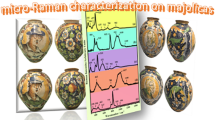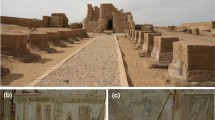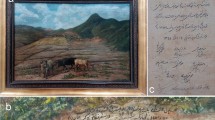Abstract
A relevant subject of study in the sphere of ancient Egyptian painting technology is given by the evolution of the palette across New Kingdom, Ptolemaic and Roman periods. Functionally to secondary factors such as geographic occurrence of minerals and type of associated surface, the employment of certain painting materials provides relevant insights into particular issues such as relative dating of the object and social rank of the owner. The Book of the Dead of Amenemhet (ROM 978 × 43.1, middle Ptolemaic Period) has been analysed at the Department of Restoration and Conservation of Archivals, Graphics and Book Illumination of the Cologne Institute of Conservation Sciences (Germany). Together with visible reflectance spectroscopy, digital and optical microscopy, devices such as XRD, SEM-EDX and FT-IR have been successfully employed for the characterization of the pigments from the polychrome funerary papyrus displayed at the Royal Ontario Museum, Toronto (Canada). The present research took place within a series of investigations performed at the CICS, devoted to the interdisciplinary study of funerary Egyptian papyri dating from the early 18th Dynasty onwards.













Similar content being viewed by others
References
Aliatis I, Bersani D, Campani E, Casoli A, Lottici PP, Mantovan S, Marino IG (2010) Pigments used in Roman wall paintings in the Vesuvian area. Journal of Raman Spectroscopy 41:1247–1252
Ambers J (2008) Pigments. In: Middleton A, Uprichard K (eds) The Nebamun wall paintings: conservation, scientific analysis and display at the British Museum. Archetype, London, pp 31–40
Augusti S (1967) I Colori Pompeiani. Roma. Ed. De Luca
Baraldi P, Baraldi C, Curina R, Tassi L, Zannini P (2007) A micro-Raman archaeometric approach to Roman wall paintings. Vibrational Spectroscopy 43:420–426
Bianchetti P, Talarico F, Vigliano MG, Fuad Ali M (2000) Production and characterization of Egyptian blue and Egyptian green frit. Journal of Cultural Heritage 1:179–188
Blom-Böer I (1994) Zusammensetzung altägyptischer Farbpigmente und ihre Herkunftslagerstätten in Zeit und Raum. OMRO 74:55–107
Caley ER, Richards JF (1956) Theophrastus on stones. The Ohio State University, Columbus (OHIO)
Cardon D, Du Chatelet G (1990) Guide des Teintures Naturelles, Lausanne: Delachaux et Niestle’
Casoli A, Campani E, Aliatis I, Mantovan S, Bersani D, Marino IG, Lottici PP (2008) Studio di pigmenti di epoca romana dall’ area Vesuviana. Atti del V Congresso Nazionale di Archeometria, Siracusa 26–29 febbraio 2008. Ed: Morrone, pp 243–253
Colinart S (2001) Analysis of inorganic yellow colour in ancient Egyptian Painting. In: Davies WV (ed) Colour and Painting in Ancient Egypt. British Museum Press, London, pp 1–5
Colombo L (1995) I Colori degli Antichi, Ed. Nardini, Fiesole (Fi)
Daniels V, Leach B (2004) The occurrence and alteration of realgar on ancient papyri. Studies in Conservation 49:73–84
Di Stefano LM (2010) Systematisches Studium der physikalischen Eigenschaften und Lichtinduzierte Schädigung von Realgar (α-As4S4) und Auripigment (As2S3). In: Hauptmann A, Hahn O (ed) Metalla Sonderheft 3, Bochum Deutsches Bergbaumuseum 2010, pp 271–273
Eastaugh N, Walsh V, Chaplin T, Siddall R (2004) The pigment compendium. Elsevier Butterworth-Heinemann, Oxford
El Goresy A, Jaksch H, Razek MA, Weiner KL (1986) Ancient pigments in wall paintings of Egyptian tombs. Rep MPIHV 12:1986
Evans D, Hamburg D, Mickelson M (1980) A papyrus treatment: bringing the Book of the Dead to life. In Art Conservation Training Programs Conference, April 28–29, 1980. University of Delaware, Newark, pp 109–113
Fuchs R (1982) Gedanken zur Herstellung von Farben und der Überlieferung von Farbrezepten in der Antike am Beispiel der in Ägypten verwendeten Blaupigmente. Diversarum Artium Studia, Beiträge zu Kunstwissenschaft, Kunsttechnlogie und ihren Randgebieten. Dr. Ludwig Reichert Verlag Wiesbaden, pp 195–208
Fuchs R (1985) Thénards Blue -A new known artificial colour in Ancient Egypt, Abstracts of Papers, Vierter Internationaler Ägyptologen-Kongress, München 26.8.–1.9.1985, pp 64–65
Fuchs R, Di Stefano LM (2010) Untersuchungen einer altägyptischen Malerei der 18. Dyn.—Die Erfindung der körperlichen Darstellung in der altägyptischen Kunst. In: Hauptmann A, Hahn O (ed) Metalla Sonderheft 3, Bochum Deutsches Bergbaumuseum 2010, pp 158–160
Fuchs R, Rauschel A (forthcoming) Produktion und Korrosion von Ägyptisch Blau und Ägyptisch Grün
Gamberini MC, Baraldi C, Palazzoli F, Ribechini E, Baraldi P (2008) MicroRaman and infrared spectroscopic characterisation of ancient cosmetics. Vibrational spectroscopy 47:82–90
Green L (2001) Colour transformations in ancient Egyptian pigments. In: Davies WV (ed) Colour and Painting in Ancient Egypt. British Museum Press, London, pp 1–5
Heywood A (2001) The use of huntite as a white pigment in ancient Egypt. In: Davies WV (ed) Colour and Painting in Ancient Egypt. British Museum Press, London, pp 5–9
Hühnerfuß K, von Bohlen A, Dieter K (2006) Characterisation of pigments and colors used in ancient Egyptian boat models. Spectrochimica Acta B 61:1224–1228
Jaksch H (1985) Farbipigmente aus Wandmalereien altägyptischer Gräber und Tempel: Technologien der Herstellung und mögliche Herkunftsbezeichnungen. Inaugural-Dissertation zur Erladung der Doktorwürde der naturwissenschatlichen Gesamtfakultät der Ruprecht-Karls-Universität Heidelberg
Kohler T, Armbruster T, Libowitzky E (1997) Hydrogen bonding and Jahn–Teller distortion in groutite, α-MnOOH, and manganite, γ-MnOOH, and their relations to the manganese dioxides ramsdellite and pyrolusite. Journal of Solid State Chemistry 133:486–500
Le Fur D (1994) La Conservation des Peintures Murales des Temples de Karnak. Editions Recherche sur les Civilisations, Paris
Lee L, Quirke S (2009) Painting materials. In: Nicholson PT, Shaw I (eds) Ancient Egyptian materials and technology. Cambridge University Press 2009 (Fifth Print), Cambridge, pp 104–121
Lucas A (1962) Ancient Egyptian materials and industries. 4th ed. rev. J.R. Harris. Edward Arnold, London
Mazzi F, Pabst A (1962) Reexamination of cuprorivaite. American Mineralogist 47:409–411
Middleton A, Humphrey S (2001) Pigments on some middle Kingdom coffins. In: Davies WV (ed) Colour and painting in Ancient Egypt. British Museum Press, London, pp 10–16
Moussa AMA, Kantiranis N, Voudouris KS, Stratis JA, Ali MF, Christaras V (2009) The impact of soluble salts on the deterioration of pharaonic and Coptic wall paintings at Al Qurna, Egypt: Mineralogy and Chemistry. Archaeometry 51(2):292–308
Olsson AMB, Calligaro T, Colinart S, Dran JC, Lövestam NEG, Moignard B, Salomon J (2001) Micro-PIXE analysis on ancient Egyptian papyrus: identification of pigments used for the “Book of the Dead”. Nuclear Instruments and Methods in Physics Research B 181:707–714
Pabst A (1959) Structures of some tetragonal sheet silicates. Acta crystallographica 12:733–739
Pages-Camagna S, Colinart S (2003) The Egyptian green pigment: its manufacturing process and links to Egyptian blue. Archaeometry 45(4):637–658
Pearce CI, Henderson CMB, Pattrick RAD, van der Laan G, Vaughan DJ (2006) Direct determination of cation site occupancies in natural ferrite spinals by L 2, 3 X-ray absorption spectroscopy and X-ray magnetic circular dichroism. American Mineralogist 91:880–893
Pliny (Hist. nat.) In: König R, Winkler R (eds) Plinius Naturkunde/Naturalis historia. Artemis Verlag, Zürich 1999ff
Riederer J (1987) Archäologie und Chemie-Einblicke in die Vergangenheit. SMPK/Rathgen-Forschungslabor, Berlin
Russell WJ (1893–4) Ancient Egyptian pigments. Nature 49:374–375
Scott DA, Warmlander S, Mazurek J, Quirke S (2009) Examinations of some pigments, grounds and media from Egyptian cartonnage fragments in the Petrie Museum, University College London. Journal of Archaeological Science 36:923–932
Shedid AG (1988) Stil der Grabmalereien in der Zeit Amenophis´II.Untersucht an der Thebanischen Gräbern Nr. 104 und Nr. 80. Deutsche Archäologisches Institut, Abteilung Kairo, Archäologische Veröffentlichungen 66, Mainz am Rhein: von Zabern
Spurrel FCJ (1895) Notes on Egyptian colours. Archaeological Journal 52:222–239
Uda M (2004) In situ characterisation of ancient plaster and pigments on tomb wall in Egypt using energy dispersive X-ray diffraction and fluorescence. Nuclear Instruments and Methods in Physics Research B 226:75–82
Uda M, Nakamura M, Yoschimura S, Kondo J, Saito M, Schirai Y, Hasegawa S, Baba Y, Ikeda K, Ban Y, Matsuo A, Tamada M, Sunaga H, Oshio H, Yamashita D, Nakajima Y, Utaka T (2002) “Amarna blue” painted on ancient Egyptian pottery. Nuclear Instruments and Methods in Physics Research B 189:382–386.
Vahur S, Teearu S, Leito I (2010) ATR-FT-IR spectroscopy in the region of 550–230 cm−1 for identification of inorganic pigments. Spectrochimica Acta Part A: Molecular and Biomolecular Spectroscopy 75(3):1061–1072
Wagner B, Donten ML, Bulska E, Jackowska A, Sobucki, W (2002) Identification of inks and pigments in ancient Egyptian Book of the Dead by SEM-EDS. In Art 2002: 7th International Conference on Non-Destructive Testing and Microanalysis for the Diagnostics and Conservation of the Cultural and Environmental Heritage: 2–6 June 2002, Congress Centre Elrenveld, Antwerp, Belgium, proceedings. Eds: Grieken R van, Janssens, K, Van´t Dack L, Meersman G, University of Antwerp, pp 1–7
Wallert A (1984) Orpiment and realgar. Maltechnik Restauro 90:45–57
Wallert A (1995) Unusual pigments on a Greek marble basin. Studies in Conservation 40:177–188
Winter J (1983) Characterization of pigments based on carbon. Studies in Conservation 29(1):59–69
Acknowledgements
Sincere thanks and deepest gratitude are extended to Dr. Doris Oltrogge (CICS) for her precious cooperation and to Andreas Rauschel and Sandra Uckermann (CICS) for their technical support. The authors are thankful to Mrs. Irmtraut Munro for all the important advices and the kind availability, and nonetheless, to Mrs. Roberta Shaw und Mrs. Cathy Stewart (Royal Ontario Museum, Toronto) for making the present research possible.
Author information
Authors and Affiliations
Corresponding author
Rights and permissions
About this article
Cite this article
Di Stefano, L.M., Fuchs, R. Characterisation of the pigments in a Ptolemaic Egyptian Book of the Dead papyrus. Archaeol Anthropol Sci 3, 229–244 (2011). https://doi.org/10.1007/s12520-011-0054-3
Received:
Accepted:
Published:
Issue Date:
DOI: https://doi.org/10.1007/s12520-011-0054-3




